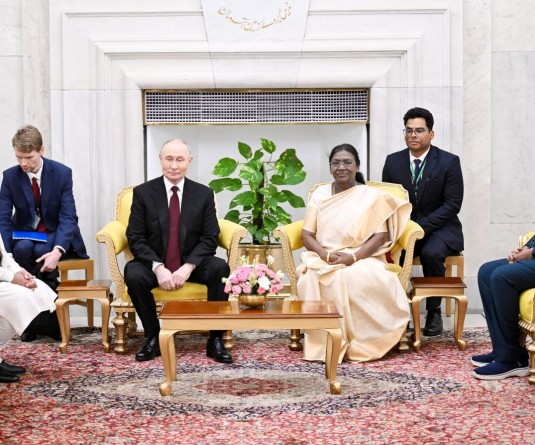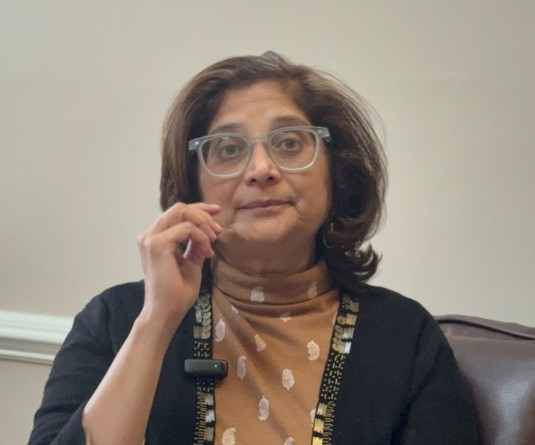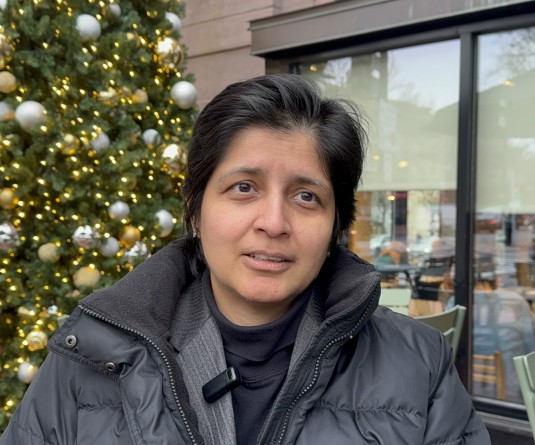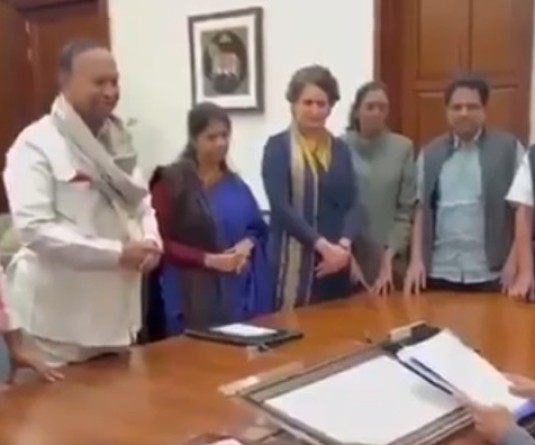Image Source: IANS News
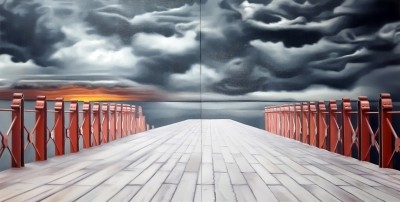
New Delhi, March 31 (IANS) Comprising installations, assemblages, sculptures, paintings and woodcuts, major Indian artist Riyas Komu tells IANS that his latest exhibition 'SALT' that opened in Mumbai recently is an act of remembrance, an attempt to preserve and pickle certain memories, and an invocation to reflect upon what essentially permeates the web and weave, the heart and soul of our social being. Excerpts from the conversation with the co-founder of Kochi Biennale:
How was 'SALT' conceived?
SALT was conceived in the last five months presenting a key work titled 'Geometric Ancestry of Drawings' and it also revisits my early work, 'My Father's Balcony', a reminder of cultures. The latter is a work that I did in 2006 as part of Faith Accompli a solo show in response to the growing seeds of discord. Beyond being a mere nostalgic trip, the work attempts to capture the aesthetic multicultural intensity that I grew up with.
The physical-metaphorical, chemical-political resonances of this mineral constitute the soul and sweat of these works; they figure history and contextualise its salty traces and sediments in the form of memories, dreams and nightmares, icons, and idols. The taste of making, the memories that haunt the collective unconscious and iconic traces that provoke civilizational conscience is persistent here. Here the works oscillate between past and present, icons and apparitions to feel the taste of what binds and divides, what is preserved and what is left to decay. They are recalling memories and reimagining memorials of political caution and cultural nourishment.
In Sanskrit, lavanyam means saltness, the taste or the property of salt; it also means beauty, loveliness, prettiness, handsomeness, comeliness; gracefulness of figure and also it is the word for aesthetics. In the Bible, salt symbolises purity, perfection, wisdom, hospitality, durability and fidelity. More than a classical retrospective approach, the show discusses an introspective possibility of art making.
Memory and history have always been important for you...
Yes, memory does play a big role in my works. The reason for titling the show, SALT as a metaphor permeates from the historical and mythical presence of it in our memories...Salt permeates and pervades in time, space, objects and contexts. It is the trace and spice of life, a symbol of incorruptibility and immanence. It is a mineral that has journeyed with human civilization, nourishing bodies and minds, adding taste and resisting decays. Culturally, it binds us all together as a symbol of mutual trust; it denotes bonding, enduring solidarity and ever-renewed camaraderie and, in India, the epic Salt March � the gentle and defiant, symbolic and evocative protest that inspired popular resistance to fight one of the most powerful empires in the world.
For example, if one of the works from the show titled 'Dandi Bridge' (2019), certain locations persist through time, as sites of history. Dandi Bridge is one such historic site that connects the present through its linkages with a certain past, thought and action, dreams and possibilities through the visual site of the bridge as metaphors of distance and closeness. Here, the bridge is known by its opposite � in keeping two landscapes apart, it also unites the two horizons. As the Palestinian poet, Mahmoud Darwish writes in his poem, 'A Dense Fog at the Bridge', "This is the gate. The gate of truth. We cannot enter and we cannot depart. The one thing is not known by its opposite. Passageways are blocked And the sky is narrow and grey-faced." It's a visitation from history, a wake-up call, or an appeal to just remember. A bridge buttressed on both sides by red iron bannisters, paved with wooden planks, leading up to a dark oceanic expanse - to an open sea of salt, Salt of Freedom. Dark, reddening clouds are thickening on the horizon and the light of our times seems to vanish and pushing us further into the thought of history. When our hopes turn into shambles of despair or when we become the victims of tragic injustice and exploitation, we are forced to remember sacrifices and histories of disobedience to seek Truth and taste the salt of the water.
You've always rejected the tag of a 'political artist' but have also insisted that only that art survives which has strong social and political contexts.
We inhabit a time, bound up with enforced dreams of progress, and in disrespecting history, our present gets further distanced from the lived past, and anticipates a future of superficiality. Within the world of art, the threat is this: We may silently become blind producers and consumers, fearing the repercussions of other people's sentiments, prejudices and positions.
In the everyday circulation of stories, we see not just the movement of an image, a video clip, a text or a small film, but also a display of egos, stereotypes, violence, jargon and judgements. We are pushed to become agents of violence -- the hegemony of narratives also makes us purveyors of false and dangerous stories. Though we are endowed with the power to see (and by extension the power to create, judge, reflect, think and interpret), we also possess the faculty of doubt.Today, we are fearful of using this so as not to upset the homogeneous order of things. This creates the conditions for a certain kind of mediocrity to become the currency of exchange, in which art becomes a commodity circulated by agencies and propped up by idle conversations. We slide towards sites of sightlessness in which certain practices and questions are invisibilised. In this state of imposed blindness, the system of the exhibition is estranged from key practices of production. Working in an almost algorithmic system of manipulation, our 'visually impaired' languages devitalise the critical capacity of art for reflection and transformation. It is a crucial hour to fight this and I disagree to fall into this trap. Through making art I urge myself to engage with social issues and converse and that is why I produced the current show in the time of Covid titled Salt as it reminds me of the words -- You are the salt of the Earth.
In the present social and political circumstances (the farmers' agitation at Delhi's doorsteps, anti-CAA protests), we are witnessing novel forms of protests including on social media. What do you think about the space of dissent in these times?
I think our task should be to create and nurture spaces where we can think collectively for the communities of the future. We must make art, fight for more facilities and share them as our forefathers used to, when they gathered around meals and feasts, with music and dance to celebrate togetherness. Today, we experience globally that all spaces of dissent are under severe surveillance. Truth suffers. But I feel counter surveillance has become a tool of protest in social media. As an artist, I feel such circumstances provoke creative imagination, provoke research, build historic perspectives, push artists into making technological interventions and as a crucial outcome the process of thinking enters the making... It is important to build communities and sites of dissent for social transformation as it bridges new conversations...
How did the lockdown treat you? Was it possible to be productive or was the period too suffocating?
I was locked inside myself, and isolation allowed me to introspect my art, life and engaged me more in thinking. I am fortunate that I have both my studios within walking distance from home. It was also the period that I got to renew myself from the hectic schedules of travels for art administration.
But as an observer, to say the least, I have to say that I haven't seen the art world coming together enough during the present crisis. Covid provoked me to argue what wish can one make to enable all of us to move in alliance with history and nature? How can we develop better institutions and networks that help artists to take risks, sustain themselves and create conditions for creative dialogues? These questions are not to be posed only keeping in mind artists, art fairs and museums, but also us as citizens with critical faculties.
How much do you derive from other art forms. You have always been fond of World Cinema.
Yes, there was a time I was hugely fond of cinema. But today as an art form it grows and grows and grows inside you...In a recent interview with Dr C.S. Venkiteshwaran as part of honouring him with a lifetime achievement award by Thiruvananthapuram International Film Festival master filmmaker Godard spoke of his current engagement post covid. He said he started researching about his grandmothers and found the link with many generations. Isn't it fascinating from a legend like Godard?
For the last 15 years, memories of social and political actions, diverse human settlements, learnings from extensive travels in the subcontinent, retrieving historic memories through the representation of sites, seeing the migration crisis, experiencing social displacement, facing tragedies of people, conflicting religions has become my site of inquiry. I try to learn art by seeing people as heritage.
You started the Students Biennale. When it comes to introduction to arts, sadly, what we mostly have for children is drawing class in school. What do feel about the need to have interesting art appreciation courses from the school level itself?
Students Biennale was conceived as a site to invoke the idea, 'Making as Thinking', to share talent and build confidence among the learners. It helped us as an institution to survey the problems of the Indian art education system. It also exposed students to the global art of great contemporary artists made in Kochi and it helped them to meet, discuss their works, engage in the production of senior artists works and learn and unlearn...
It is important that we create an ecosystem in which art is part of our commons. At present, our art education consists of art and craft classes at the school level and then specialised fine arts programmes at the college level. We should think about academies that impart education and generate thinking in the humanities and sciences, philosophy since they are the material, the medium and the object of contemporary art.
In India, craft and skill are vital parts of traditional and contemporary culture. We are fortunate to have rich and challenging visual cultures, but we are not given the critical tools to reflect on them. Our learning should have the space for both historical as well as tactile engagement with craft cultures. The materiality of global artistic practices should be familiar to every student. We should endorse and support art as social beings. We should employ our imaginations and energies towards a new culture of learning art that is also a new culture of learning itself. We initiated ABC (art by children) to create a spark towards this kind of thinking. I hope schools come forward in engaging children in art.
How has Mumbai shaped you as an artist. What is the kind of energy that you derive from Kerala?
I reached Mumbai in the crucial year 1992 to study textile design. But circumstances made me an artist. I realised an Indian villager moves to a city by leaving behind his simple life, farmland, faith, religion, cultures and his deities, families, Gods, ancestry and sense of belonging and stability to escape from caste and class discriminations. In that context, I feel my love for Mumbai is centuries old. This is the love people show towards this magical city when they can forget their cast, religion & class. Kerala taught me many things through its history of public action. I carry beautiful memories of living with my parents, their social life and their love for people with me.
What has been happening at the Uru Art Harbour lately?
As you know, URU Art Harbour is a space for collaboration, uncensored artistic expression, critical inquiry, and creative disruption. Located in one of the oldest warehouses in the country that was once owned by the legendary trader, Thangal Kunju Musaliar. Space reflects core ideas of URU such as foregrounding local histories and an engagement with human migration and settlements. Recently URU published an important book of writings by Sanil V, professor of humanities and social science at IIT Delhi. Our residencies are starting next month onwards.
Can't help asking this one -- you're quite fond of cooking. What does it do to you?
Covid time, I engaged a lot in cooking with my family. Now it began when humans learned to control fire. It is a meditative way of playing with fire and the ability to cook teaches great human stories of settlements and I cherish them.


